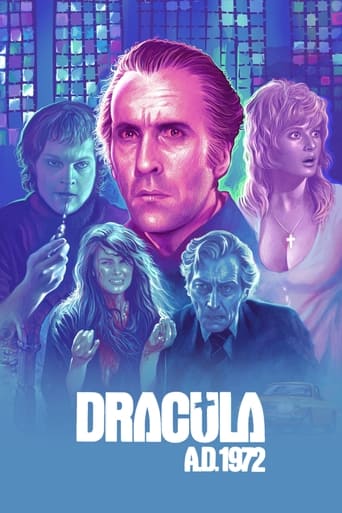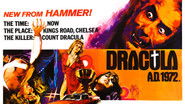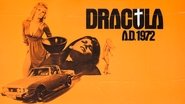JLRVancouver
Despite the presence of Hammer's iconic Gothic duo of Peter Cushing and Christopher Lee, "Dracula AD 1972" is a pretty mundane entry into the Dracula canon. Briefly, a group of counter-culture types get tricked into an unholy attempt to resurrect the blood-sucking count by "Johnny Alucard" (Christopher Neame) with predictable results. One of participants at the dark ceremony is the granddaughter of Professor Lorrimer Van Helsing (Cushing), who is in turn the grandson of Lawrence Van Helsing, who had dispatched the vampire exactly 100 years earlier and a vengeful Dracula (Lee) is out for blood, figuratively and literally. Cushing and Lee are fine playing their standard tropes but the youths are an uninteresting bunch and I doubt if anyone will much care if they live or die or undie. The worst part of the film is the soundtrack. I can accept that, when the music is actually embedded in the story (such as in the bar), then the music needs to match the scene but most of the score is simply background and setting Dracula and van Helsing's climatic showdown to cheesy '70's cop-show music quickly kills any sense of drama or horror. There are a number of ridiculous scenes such as Van Helsing working out the mystical significance of 'Aulcard's name as though he was deciphering the Rosetta stone, gory scenes with blood that sometimes looks like catsup, other times like vermillion poster paint, and above all Christopher Neame's hammy summoning of the Prince of Evil (admittedly a good 'who's who' of evil). Presumably, the film was an attempt of Hammer to ingratiate itself into a new generation of viewers and the film opens with the groovy, free-loving, hippie-types crashing a party hosted by a bunch of snooty 'upper class' types who are mocked for their 'squareness' until the 'fuzz' show up (a scene that serves no real purpose other than establish the 'hipness' of the film). The scenes featuring Cushing and Lee are too brief and the rest of the movie is not really worth watching, so this one's a miss for all but core vampire fans.
Nigel P
In a move that seems to confirm the events covered in 1958's original 'Dracula' weren't the only time The Count fought his enemy Van Helsing, this updating of Hammer's vampire myth begins with a spectacular scuffle between Peter Cushing and Christopher Lee atop a speeding stagecoach. The grim and gruesome climax results in the death of both, revealing a continuity error – events covered in 'Dracula' happened in 1885, 13 years after this prologue. Perhaps the Van Helsing featured there was a relation of this one! The decision to move the Lord of the Undead into modern times has been lambasted over the years by horror fans, not least because the hip dialogue between the hippy gang was dated even then. The intervening years have been forgiving however – viewed now, this updating is now a period piece, and phrases like 'Dig the music kids' seems to be part and parcel with the overall 'flares and winged-collars' styles of the day.There's a knowing, pseudo-parody feel about this too. Describing a victim as 'a bit drained' and inviting someone to 'come in for a bite' evokes an atmosphere at odds with the grim and serious presence of Dracula and his various machinations, giving the impression Hammer weren't entirely confident about the direction in which this series should go. Their recent 'Horror of Frankenstein (1970)' was laced with similar comedy and was received very poorly.After bringing their vampire into the then present day, the writers then decide to keep him very much apart from it. All Dracula's scenes take place in or around a deconsecrated church, and any interaction with life in 1972 is left to Christopher Neame's enjoyably over-the-top Johnny Alucard. His fight with Van Helsing is a high-point (lots of nice directorial moments from Alan Gibson), but it does rob Dracula of screen-time, as usual.This is good fun though, in much the same way Universal's latter-day horrors were good fun – little in the way of actual horror atmospherics, but a fast-pace monster piece. And to its credit, the now traditional decomposition of Dracula in the finale is one of the most gruesome of the entire series.
TheLittleSongbird
The Hammer Dracula series was mostly solid and entertaining, but the last three films were disappointing and three of Hammer's lesser efforts. Dracula A.D. 1972 has often been considered the worst of the Hammer Dracula films, for me it is one of the weakest along with Satanic Rites but by no means unwatchable.Starting with what's good, the best assets are Peter Cushing and Christopher Lee. Cushing brings real dignity and class here to a character that ranks with his best, his dialogue is often absolutely terrible but he remarkably delivers it with much conviction and seriousness(without being overly so). Lee has very little screen time and even little dialogue but is a towering presence and the embodiment of evil. The cast generally actually are decent, with the most memorable being Christopher Neame, he overacts at times and does seem to be trying too hard at times to channel Malcolm McDowell in A Clockwork Orange but he is incredibly charismatic, very sinister and is so much fun to watch. There are three good scenes, the genuinely exciting opening coach fight which features one of Dracula's most memorable demises of the series, Dracula's resurrection which is one of the series' most imaginative and the tense and entertaining ending which is one of the series' better and more plausible ones. The photography is incredibly stylish and the lighting has a lot of vibrancy and atmosphere.However, Dracula A.D. 1972's biggest problem is that it is very dated(especially in the production values, script and music), a term I try to avoid using but I do feel that it applies here. And this is not just by today's standards, it was dated back in 1972 as well. The sets are really lacking in atmosphere and are quite tacky and gaudy in colour, a cheaper version of Austin Powers. The very 1970s costumes and hair-styles are pretty much the same. The script is howlingly bad, Cushing has the worst of the dialogue(some of which are endless explanations) but the howlers come from Alucard, and while it provides some unintentional entertainment at first it gets very tiresome soon after. The film even tries to incorporate some Dracula mythos, but does absolutely nothing with it, a decent idea wasted. The soundtrack dates the film terribly, not only does it sound incredibly cheesy but it is always incongruous with what is going on, with tense scenes almost completely ruined by inappropriately 'groovy' music.The story has its moments, but does drag badly and was in serious need of more suspense, mystery, excitement and tension. It is especially bad in the party scene, which goes on forever and serves no point to the story at all, instead showing off an exhausting display 1970s fashions and behaviour at its worst, complete with the most unconvincingly played hippies for any film. The direction is often far too languid, the characters are not really all that interesting or engaging(with the most important characters being severely under-utilised, Dracula and Van Helsing's rivalry is so much more interesting than everything else in this film, why not show more of it?) and while most of the acting from the main players is decent, Caroline Munro is mesmerising to watch but is wasted by being killed off too soon, Stephanie Beacham is sexy but quite vapid and the acting for the hippies is mostly terrible.All in all, not unwatchable but one of the weakest of the Hammer Dracula series and lesser Hammer overall. 5/10 Bethany Cox
Wuchak
England's Hammer Studios did 9 Dracula or vampire films from 1958-1974:1. Horror of Dracula (1958); 2. Brides of Dracula (1960); 3. Dracula, Prince of Darkness (1966); 4. Dracula has Risen from the Grave (1968); 5. Taste the Blood of Dracula (1970); 6. Scars of Dracula (1970); 7. Dracula A.D. 1972 (1972); 8. The Satanic Rites of Dracula (1973); and 9. The Legend of the 7 Golden Vampires (1974).Christopher Lee plays the Count in all but "The Brides of Dracula" and "The Legend 7 Golden Vampires." Peter Cushing also stars in four entries as Van Helsing.By the time of the seventh film the creative well was apparently running dry and Hammer decided to spice up the series by bringing the Count to present-day London (1972, of course), which was Hammer's response to other successful vampire films at the time taking place in the modern day, such as "The Night Stalker," "Blacula" and "Count Yorga." The story revolves around a group of hip counter-culture youths performing a black mass in an abandoned church for kicks (although the ringleader takes it serious) and they revive the blood-sucking prince of darkness. Havok ensues.Peter Cushing appears as Van Helsing's descendant. Christopher Neame plays the nutjob who performs the black mass with utter relish. Also on hand are the stunning beauties Stephanie Beacham and Caroline Munro. Stephanie plays Van Helsing's daughter and Caroline has a small but significant role. There are a couple of other early-70s hippie babes as well.The first half of the film borrows heavily from the previous "Taste the Blood of Dracula" in that the Count is resurrected in roughly the same manner, although "Taste" is more effective. Which isn't to say that "Dracula A.D. 1972" isn't a decent entry in the series, albeit bizarre. The main problem with the film is that the story doesn't seem to know what to do once Dracula is resurrected. For instance, Cushing's final battle with the Count is fairly lame for various reasons (I don't want to give anything away), not to mention Lee only appears for about 10 minute in the entire film, which is usual for the series, of course.Another problem is the score. It screams "early 70s" in a bad way, but doesn't mesh with what is essentially a serious horror flick. Of course some would cite that as part of its charm. I said "serious horror flick, by the way, because this is not a goofy or campy flick despite the colorful hippie elements and lousy score.What works best is that it's a great period piece. You'll get a groovy glimpse of England's counter-culture, including the hippie girls and a live performance by the band Stoneground (who didn't go anywhere beyond this movie, likely because their sound & style was already passe by 1972). So, the first half is fun and compelling, whereas the second half just sort of goes through the motions and peters out.BOTTOM LINE: "Dracula A.D. 1972" is hard to rate because, despite the mediocre-ness of the story's second half, the film is a fun experience with numerous highlights. Hence, as a Dracula story I give it a C+, but for entertainment value I give it a solid B or B+.The film runs 96 minutes and was shot in England.GRADE: B-






